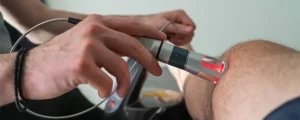What is Shockwave Therapy and How Does It Work?
Shockwave therapy is a non-invasive treatment that uses acoustic waves to promote healing and reduce pain in various musculoskeletal conditions. It’s like giving your body a little wake-up call! The process involves sending sound waves through the skin to the affected area, which stimulates circulation and encourages tissue regeneration.
So, how does it work? When the shockwaves hit the target area, they create micro-traumas that kickstart your body’s natural healing response. This boosts blood flow and breaks down calcified tissues, making it an effective option for conditions like plantar fasciitis, tendonitis, and even some types of joint pain.
Common Conditions Treated with Shockwave Therapy
Shockwave therapy is gaining traction as a go-to treatment for various musculoskeletal conditions. Here’s a quick rundown of some common issues it can help with:
Plantar Fasciitis: A painful condition affecting the bottom of your foot, shockwave therapy can reduce inflammation and promote healing.
Tendinitis: Whether it’s in the elbow (tennis elbow) or shoulder, this therapy helps alleviate pain and restore mobility.
Calcific Shoulder Tendinopathy: Shockwave therapy can break down calcium deposits in the shoulder, easing pain and improving function.
Achilles Tendinopathy: This treatment stimulates healing in the Achilles tendon, which is often plagued by overuse injuries.
Patellar Tendinopathy: Known as jumper’s knee, shockwave therapy targets this common issue among athletes to speed up recovery.
Muscle Strains: From hamstrings to quadriceps, shockwave therapy can enhance muscle recovery after strains or pulls.
Joint Pain: Conditions like osteoarthritis may also see benefits from shockwave treatments by reducing pain and improving joint function.
By targeting these conditions effectively, shockwave therapy offers a non-invasive alternative that many are finding beneficial!
The Benefits of Choosing Shockwave Therapy Over Traditional Treatments
When it comes to pain management and healing, many are turning to shockwave therapy as a fresh alternative to traditional treatments. Here’s a quick rundown of the benefits that make this option stand out:
Non-Invasive: Unlike surgeries or injections, shockwave therapy is non-invasive, meaning no downtime and less risk of complications.
Quick Sessions: Treatments are usually short, often lasting only 15-30 minutes, making it easy to fit into your busy schedule.
Fewer Side Effects: With minimal discomfort and side effects compared to medications or invasive procedures, patients often find it a more appealing choice.
Effective for Various Conditions: Whether it’s tendonitis, plantar fasciitis, or chronic pain issues, shockwave therapy has shown effectiveness across a wide range of conditions.
Stimulates Healing: This therapy promotes blood flow and stimulates the body’s natural healing processes, which can lead to faster recovery times.
Long-Lasting Relief: Many patients report significant pain relief that lasts long after treatment sessions have ended.
Who is a Good Candidate for Shockwave Therapy?
If you’re wondering whether shockwave therapy might be right for you, it’s essential to understand the patient eligibility criteria. Generally, good candidates are those dealing with chronic pain conditions like plantar fasciitis, tendonitis, or other musculoskeletal issues that haven’t responded well to traditional treatments.
However, it’s not a one-size-fits-all solution. Your medical history plays a crucial role in determining your suitability for this therapy. For instance, if you’ve had recent surgeries in the treatment area or have certain conditions like infections or tumors, shockwave therapy may not be advisable.
Additionally, there are specific contraindications to consider. If you’re pregnant or have a blood clotting disorder, you should steer clear of this treatment. It’s always best to have an open conversation with your healthcare provider about your medical history and any concerns you might have before diving into shockwave therapy. This way, you can make an informed decision that’s right for your health journey!






